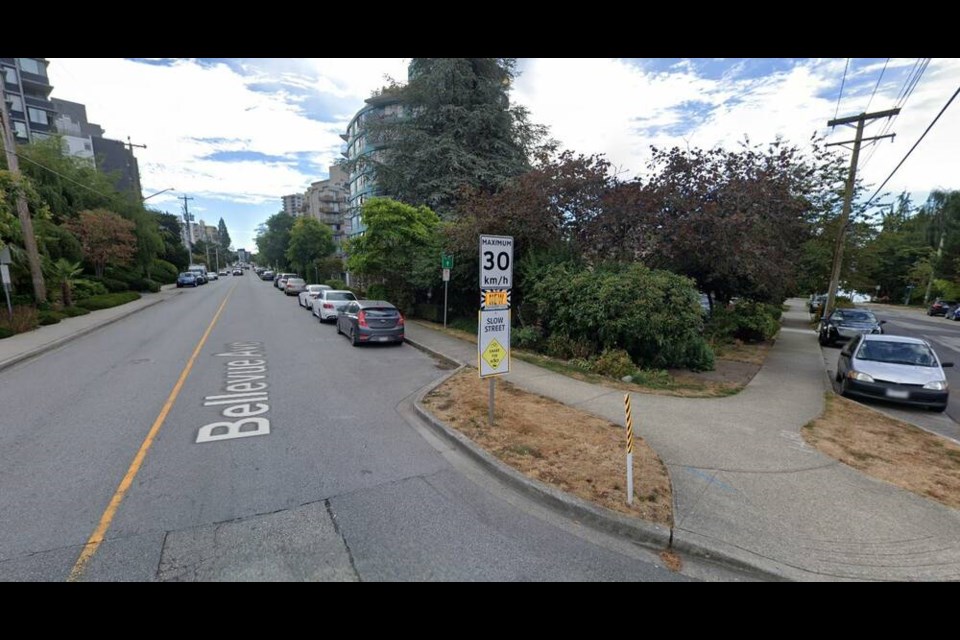In a municipality where luxury SUVs and sports cars rule the roads, many of which are devoid of sidewalks, every resident can name a street or intersection that they feel is unsafe – members of council included.
On Monday, District of West Vancouver council voted unanimously to support a series of recommendations by staff to improve road safety in the district.
The recommendations include redirecting funds from a dubious speed reduction initiative to an ongoing program to improve road safety near schools, directing staff to target specific locations where data shows improvement is needed, directing staff to identify intersections with the highest collision rates, and encouraging the province to add more red light and speed cameras at intersections.
The initiative stems from council’s 2020-21 strategic plan, which had a section on improving mobility, while reducing congestion for people and goods. Stated objectives were to improve the safety and appeal of active transportation options.
Before Monday’s vote, staff made a presentation to council with results from two related speed-reduction pilots conducted over the past two years. The first one-year pilot happened 2020-21 on Fulton Avenue, between 12th and 16th Street, and Bellevue Avenue, between 17th and 25th Streets. Signs were placed, indicating a reduction to 30 kilometres per hour from 50 km/h, with no further traffic calming or enforcement measures.
Staff found that the signs had no measurable impact on driving speed. Most people drove on Bellevue 42-44 km/h and 50-52 km/h on Fulton before and after the new signs were installed.
A second pilot was carried out in 2022-23 , to collect speed and collision data on Kings (21st to 25th Street), Jefferson (21st to 24th Street), Inglewood (Haywood to 22nd Street) and Haywood (22nd to 25th street).
In the three 30 km/h school zones in that pilot, staff found most drivers travelled 5 to 12 km/h over the speed limit. In the other 50 km/h zones, people drove 3 to 13 km/h under the speed limit.
Within the study area, staff noted ICBC data showing 11 injury collisions involving pedestrians, cyclists or vehicle passengers. Around 72 per cent of injury collisions were on collector or arterial roadways, and all happened at intersections. Two collisions in the area involved pedestrians and two involved cyclists.
“When we looked at the data – that the speeds we were observing were not tied to what the posted speeds were … that there were not many collisions occurring on local roads – we asked the question: to reduce the collisions in West Vancouver, is it better to have a broad blanket impact of reducing the speeds on local roads? Or is it better to focus to identify target locations that have a high collision area?” said Sean O’Sullivan, senior manager of roads and transportation.
He noted that the district has already started working with local schools to identify and implement quick fixes, like changing signs and repainting crosswalks, to improve safety and mobility in surrounding areas.
But West Van doesn’t have a traffic calming policy, O’Sullivan said, so currently it’s not clear on how staff can be fair and consistent in responding to residents asking for road safety improvements.
“Right now, the procedure that we’re following doesn’t have a way of prioritizing and fairly evaluating when we get requests for traffic calming,” he added.
Staff proposed they carry out a screening study to identify the most dangerous areas and focus on coming up with solutions that target specific problems. O’Sullivan said staff also plan to prioritize traffic signals, many of which are outdated.
'Signs alone are insufficient' to make roads safer
Several members of council remarked on how Marine Drive has become a speedway.
“The sequence of our lights is such that if you hit a red light, then all of those in advance of that red light are green,” said Coun. Christine Cassidy. “Is there not any way of having conversations, with whomever, that if you hit one red light, maybe you’ve got one or two green, and then it’s a red?”
Staff said that modernizing traffic signal infrastructure could allow for these types of changes.
“A vehicle travelling at 50 kilometres an hour will get a green wave. If they’re going faster, you’ll get red lights,” O’Sullivan said. “But some of our equipment is so old, we don’t have the flexibility, the option to do that.”
Coun. Sharon Thompson noted that the district doesn’t “have a lot of money,” and limited resources have to be spent wisely.
“I’m a little concerned that signs and painting aren’t really going to do the trick, and cost us a lot of time and money,” she said. “But the overarching thing is the enforcement – creating these speed limits and having people say ‘You can’t get away with it.’”
“I hope that we can figure out collectively how to how to get on top of this quickly, because it is a problem that’s growing each season and month in our community,” she said.
Cycling advocate Paul Stott addressed council toward the end of the discussion.
“The report recognizes that signs alone are insufficient. And that speed management requires engineering design, and construction measures, measures that require drivers to pay attention and to recognize the vulnerability of the areas that they’re driving,” he said.
“This isn’t a question of sequencing red lights, it’s a question of putting obstacles in their way. Not too long ago, the district closed off Bellevue Avenue at 23rd … that changed the pattern of driving behaviour on that street. And honestly, for two years it went on, nobody complained,” Stott continued. “Why aren’t measures like that used more than more frequently?”
All the proposed recommendations ultimately passed, with a friendly amendment from Peter Lambur to hear back from staff by the end of year, half a year sooner than initially proposed.



